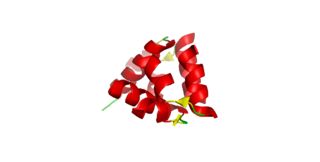Related Research Articles

The insulin-like growth factors (IGFs) are proteins with high sequence similarity to insulin. IGFs are part of a complex system that cells use to communicate with their physiologic environment. This complex system consists of two cell-surface receptors, two ligands, a family of seven high-affinity IGF-binding proteins, as well as associated IGFBP degrading enzymes, referred to collectively as proteases.

Glucagon is a peptide hormone, produced by alpha cells of the pancreas. It raises concentration of glucose and fatty acids in the bloodstream, and is considered to be the main catabolic hormone of the body. It is also used as a medication to treat a number of health conditions. Its effect is opposite to that of insulin, which lowers extracellular glucose. It is produced from proglucagon, encoded by the GCG gene.

Angiotensin is a peptide hormone that causes vasoconstriction and an increase in blood pressure. It is part of the renin–angiotensin system, which regulates blood pressure. Angiotensin also stimulates the release of aldosterone from the adrenal cortex to promote sodium retention by the kidneys.

In the field of molecular biology, the peroxisome proliferator-activated receptors (PPARs) are a group of nuclear receptor proteins that function as transcription factors regulating the expression of genes. PPARs play essential roles in the regulation of cellular differentiation, development, and metabolism, and tumorigenesis of higher organisms.

Relaxin is a protein hormone of about 6000 Da first described in 1926 by Frederick Hisaw.
Neuropeptide Y receptors are a family of receptors belonging to class A G-protein coupled receptors and they are activated by the closely related peptide hormones neuropeptide Y, peptide YY and pancreatic polypeptide. These receptors are involved in the control of a diverse set of behavioral processes including appetite, circadian rhythm, and anxiety.
The bradykinin receptor family is a group of G-protein coupled receptors whose principal ligand is the protein bradykinin.
There are two known parathyroid hormone receptors in mammals termed PTH1R and PTH2R. These receptors bind parathyroid hormone and are members of the GPCR family of transmembrane proteins.
Corticotropin-releasing hormone receptors (CRHRs), also known as corticotropin-releasing factor receptors (CRFRs) are a G protein-coupled receptor family that binds corticotropin-releasing hormone (CRH). There are two receptors in the family, designated as type 1 and 2, each encoded by a separate gene.

The glucagon-like peptide-1 receptor (GLP1R) is a receptor protein found on beta cells of the pancreas and on neurons of the brain. It is involved in the control of blood sugar level by enhancing insulin secretion. In humans it is synthesised by the gene GLP1R, which is present on chromosome 6. It is a member of the glucagon receptor family of G protein-coupled receptors. GLP1R is composed of two domains, one extracellular (ECD) that binds the C-terminal helix of GLP-1, and one transmembrane (TMD) domain that binds the N-terminal region of GLP-1. In the TMD domain there is a fulcrum of polar residues that regulates the biased signaling of the receptor while the transmembrane helical boundaries and extracellular surface are a trigger for biased agonism.

The gastrin-releasing peptide receptor (GRPR), now properly known as BB2 is a G protein-coupled receptor whose endogenous ligand is gastrin releasing peptide. In humans it is highly expressed in the pancreas and is also expressed in the stomach, adrenal cortex and brain.

Bradykinin receptor B2 is a G-protein coupled receptor for bradykinin, encoded by the BDKRB2 gene in humans.

Relaxin/insulin-like family peptide receptor 3, also known as RXFP3, is a human G-protein coupled receptor.

Relaxin/insulin-like family peptide receptor 1, also known as RXFP1, is a human G protein coupled receptor that is one of the relaxin receptors. It is a rhodopsin-like GPCR which is unusual in this class as it contains a large extracellular binding and signalling domain. Some reports suggest that RXFP1 forms homodimers, however the most recent evidence indicates that relaxin binds a non-homodimer of RXFP1.

Relaxin/insulin-like family peptide receptor 4, also known as RXFP4, is a human G-protein coupled receptor.

Relaxin/insulin-like family peptide receptor 2, also known as RXFP2, is a human G-protein coupled receptor.

The insulin/IGF/relaxin family is a group of evolutionary related proteins which possess a variety of hormonal activities. Family members in human include two subfamilies:

Relaxin-3 is a neuropeptide that was discovered in 2001, and which is highly conserved in species ranging from flies, fish, rodents and humans. Relaxin-3 is a member and ancestral gene of the relaxin family of peptides, which includes the namesake hormone relaxin which mediates peripheral actions during pregnancy and which was found to relax the pelvic ligament in guinea pigs almost a century ago. The cognate receptor for relaxin-3 is the G-protein coupled receptor RXFP3, however relaxin-3 is pharmacologically able to also cross react with RXFP1 and RXFP3.

Relaxin family peptide hormones in humans are represented by seven members: three relaxin-like (RLN) and four insulin-like (INSL) peptides: RLN1, RLN2, RNL3, INSL3, INSL4, INSL5, INSL6. This subdivision into two classes is based primarily on early findings, and does not reflect the evolutionary origins or physiological differences between peptides. For example, it is known that the genes coding for RLN3 and INSL5 arose from one ancestral gene, and INSL3 shares origin with RLN2 and its multiple duplicates: RLN1, INSL4, INSL6.
Serelaxin is a medication which is marketed in Russia for the treatment of acute heart failure (AHF), targeting the relaxin receptor. It was also under development in other places in the world, including in the United States, Europe, and Asia, but ultimately was not marketed in these areas.
References
- ↑ Bathgate RA, Ivell R, Sanborn BM, Sherwood OD, Summers RJ (2006). "International Union of Pharmacology LVII: recommendations for the nomenclature of receptors for relaxin family peptides". Pharmacol. Rev. 58 (1): 7–31. doi:10.1124/pr.58.1.9. PMID 16507880. S2CID 7466039.
- ↑ Halls ML, van der Westhuizen ET, Bathgate RA, Summers RJ (2007). "Relaxin family peptide receptors--former orphans reunite with their parent ligands to activate multiple signalling pathways". Br. J. Pharmacol. 150 (6): 677–91. doi:10.1038/sj.bjp.0707140. PMC 2013861 . PMID 17293890.